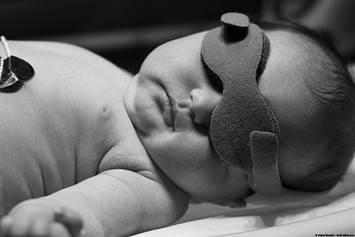Jaundice in Children
Jaundice is a condition that causes yellowing of the skin and eyes. It happens when there is too much bilirubin in the blood.
What is Jaundice in Children?
Jaundice is a very common condition in newborn babies. It usually appears in the first few days or weeks of life. Most cases of jaundice are not caused by any disease or concerning problem and clear up quickly without any treatment.
Jaundice is caused by a yellow substance (pigment) called bilirubin. The liver, spleen and bone marrow make bilirubin out of red blood cells that have broken down. The liver then passes bilirubin out of the body through bile which flows into the stool. Jaundice occurs when bilirubin cannot be removed from the body fast enough and levels in the blood become too high. The buildup of bilirubin causes the skin and the white part of the eyes to appear yellow.
There are two main types of jaundice in infants:
- Physiologic jaundice: This type is quite common. It affects about six out of 10 newborns. Physiologic jaundice happens when bilirubin does not move out of the body fast enough. Most often, it goes away on its own by the time the baby is about 2 weeks old. If it continues, treatment may be needed.
- Pathologic jaundice: Various disorders, such as infectious, endocrine (hormonal) or genetic (inherited) diseases, can keep the liver from processing bilirubin as it should. In those cases, the problem that is causing the jaundice needs to be found and treated.
What Causes Jaundice in Children?
During pregnancy, the mother’s liver breaks down the baby’s bilirubin. After birth, the baby’s own liver takes over this task. Jaundice occurs when the baby’s liver is not able to handle extra bilirubin on its own. Because a baby’s liver is still immature, jaundice is quite common. However, for most newborns, this only lasts for a few days or weeks. After that, the liver of most babies is able to handle bilirubin normally and pass it out of the body so that it won’t build up and cause jaundice.
Rarely, jaundice in children may be a sign of a more serious health issue. More testing will then be needed to find the cause and the correct treatment. Some of the health problems that can cause persistent jaundice include:
- Blood type mismatch between mother and baby, which makes baby’s red blood cells break down faster than normal and raises bilirubin levels
- Blood cell diseases, such as sickle cell anemia or glucose-6-phosphate dehydrogenase (G6PD) deficiency
- Infections, usually caused by a virus (such as the CMV virus) or bacteria (such as in a urinary tract infection). Jaundice can also be a sign of a more serious infection, such as herpes simplex or sepsis.
- Endocrine (hormonal) disorders, such as hypothyroidism (underactive thyroid) or hypopituitarism
- Conditions that block the flow of bile out of the liver (cholestasis), such as biliary atresia or choledochal (bile duct) cyst. Some of these conditions are genetic (inborn), for example cystic fibrosis, Alpha-1 antitrypsin deficiency, or Alagille syndrome
- Genetic diseases, such as Gilbert syndrome (a common, harmless condition) or galactosemia (a serious illness that must be treated with a special diet for the baby). There are many other genetic diseases that can cause jaundice, but most of them are extremely rare.
What Children Are at Risk for Jaundice?
Some infants are more likely than others to have jaundice. These include babies who are:
Premature: When a baby is born too early (before 37 weeks), the liver may not be developed enough to clear away bilirubin as fast as it should.
Breastfed: Jaundice is especially likely in babies having trouble breastfeeding, either because the baby does not feed well or because the mother does not produce enough milk. If a baby isn’t getting enough breast milk in the first few days or weeks, it may not produce enough bowel movements to clear away bilirubin. This is called breastfeeding jaundice.
For reasons not completely understood yet, breast milk itself can sometimes cause jaundice. It is thought that something in the breast milk causes the bilirubin to be processed more slowly. This is called breast milk jaundice. It can usually be observed and will go away on its own after a few weeks or a couple of months, but if the bilirubin levels become too high, some babies may need to be fed formula until the jaundice goes away.
From certain ethnic groups: Babies with an East Asian or Mediterranean ethnic background have a higher risk of jaundice.
Bruised at birth: As a large bruise heals, it can cause bilirubin levels to rise.
What Are the Symptoms of Jaundice in a Child?
- Yellowish skin and eyes: Press gently on baby’s forehead with one finger. If the pressed area looks yellow, your baby may have jaundice.
- Dark urine: Normal infant urine is light yellow or colorless.
- Pale stool: Normal stool is yellowish-green in bottle-fed babies. Breastfed babies should have mustard yellow stool. In general, a normal stool color is yellow, orange, green or brown. A baby’s stool should not be gray, beige, white or pale.
How Is Jaundice Diagnosed in a Child?
Newborn babies should be tested for jaundice before going home from the hospital or birthing center. Babies at risk for jaundice, or those who are still jaundiced more than usual, might need to be checked again after a few days. Your child’s health care provider can tell you if this is needed. If your baby is still jaundiced after 2 weeks of age (with breastfed babies one may wait as long as 3 weeks), your provider will most likely order a blood test for “total and direct bilirubin” to better understand the type of jaundice and what other tests to do.
Your baby’s health care provider will first examine your child for signs of jaundice. Other jaundice tests may include a:
- Blood test: which measures the amount of bilirubin in the blood
- Skin test: which uses a special light to measure bilirubin in the skin
How Is Jaundice Treated in a Child?
Physiologic jaundice (jaundice not caused by disease) often goes away without treatment within two weeks. During this time, the baby’s blood may need to be tested to make sure bilirubin levels are improving.
Some babies need a treatment called phototherapy. This exposes the baby’s skin to a special type of bright blue light. These “bili lights” are very safe for most babies. The light causes a chemical reaction in the skin that lets the body remove bilirubin more easily through urine and stool. Depending on bilirubin levels, phototherapy may take anywhere from a few hours to several days.
There are two types of phototherapy for jaundice:
- Conventional phototherapy: The baby is placed on a bed under a set of bili lights. These are lamps that make a special blue light. Soft eye patches protect the baby’s eyes during phototherapy treatment.
- Fiberoptic phototherapy: This treatment is done with a device called a bili blanket. It is a soft pad with blue phototherapy lights inside. The baby is placed on or wrapped in the bili blanket during treatment.
If phototherapy does not bring down bilirubin levels low enough or fast enough, a baby with severe jaundice may need a blood exchange transfusion (some of the baby’s blood is removed and replaced with donor blood), but this is rarely needed.
For children with pathologic jaundice (jaundice that is caused by disease), the best course of treatment depends on the cause. As discussed above, pathologic jaundice can have many different causes, and various tests may be needed to find out what the problem is and how to treat it.
What Are the Complications of Jaundice in a Child?
Most often, jaundice is temporary and not harmful. In rare cases, jaundice can be serious or even life-threatening. Fortunately, prompt treatment can prevent most complications of jaundice in children.
If not properly treated, jaundice can lead to serious health issues. When bilirubin levels rise dangerously high, it can harm cells throughout the body. It is possible for severe jaundice to cause brain damage (kernicterus) leading to complications such as cerebral palsy or deafness.
When Should I Call My Child’s Health Care Provider?
Call your health care provider right away if your baby is:
- Turning more yellow: Skin that becomes very yellow or orange is cause for concern. This is especially true if the yellow color spreads to the arms or the lower body.
- Feeding poorly: Your baby may have trouble breastfeeding or drinking formula from a bottle. Not eating enough can make jaundice worse.
- Sleepier than usual
- Dehydrated: Signs of dehydration (lack of fluid) include not enough wet diapers, dark urine, and no tears. If you are concerned about dehydration, remember that babies younger than 6 months of age may only drink formula or breast milk, never water. Pure water (or extra water added to the formula) can make a newborn or young infant very sick.
- Weak or inactive
- Fussy or irritable
- Losing weight or failing to gain weight
Call 911 or take your baby to the emergency room if baby has:
- Backward arching neck or body
- Trouble waking up
- High-pitched cry or will not stop crying
- Strange eye movements, such as gazing upward
Key Points About Jaundice in Children
- Jaundice is very common in newborns.
- It is usually temporary and harmless.
- Rarely is jaundice in children serious or life-threatening.
- If jaundice is prolonged (lasting longer than 2 weeks), severe (with very high bilirubin levels), or pathologic (caused by a disease), prompt attention, testing, and possibly treatment are important to prevent complications.
What are my Next Steps?
The best way to be sure your baby recovers well from jaundice is to follow the advice of your baby’s health care provider. Some of the things you can do at home may include:
- Feed baby often: Frequent feedings encourage more bowel movements. Passing more stool clears bilirubin from the body faster.
- Keep track of diapers: Less than 5-6 wet diapers a day may mean that your baby is not getting enough fluid; not enough dirty diapers may mean that your baby is not getting rid of bilirubin fast enough. Both can lead to jaundice not improving. However, breast fed babies can go several days between dirty diapers, and that may be normal. Your child’s health care provider can tell you how many diapers to expect each day.
- Ask about home phototherapy: Mild cases of jaundice can sometimes be treated at home using bili lights or a bili blanket.
- Keep follow-up appointments: Your child’s health care provider may want to see your baby often until jaundice goes away. Skin color alone is not a good way to tell if jaundice is getting worse. It is very important to have any tests done your baby’s health care provider may recommend.
Helping Hands Patient Education Materials
Written and illustrated by medical, nursing and allied health professionals at Nationwide Children's Hospital, Helping Hand instructions are intended as a supplement to verbal instructions provided by a medical professional. The information is periodically reviewed and revised to reflect our current practice. However, Nationwide Children's Hospital is not responsible for any consequences resulting from the use or misuse of the information in the Helping Hands.
HH-I-137 | ©1975, revised 2024, Nationwide Children’s Hospital


